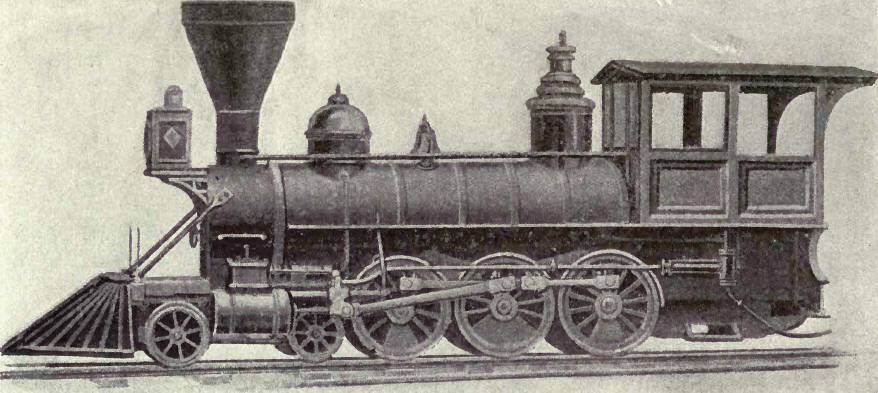|
Specifications for the
Baltimore & Ohio RR Locomotives 225 & 226 |
| |
| Confederate Names: #225 -- Hercules; #226 -- General Robert
E. Lee |
| |
| Information found in Bell, The Early Motive Power of the
Mobile & Ohio Railroad, 1912, pages 93-96, reformatted for
ease of reading. |
| |
| #225 was built in August, 1857, and #226 in September, 1857,
both by A. W. Denmead & Sons. |
| |
| Cylinders: 18" x 24" |
| Driving Wheels: 50" |
| Truck Wheels: 28" |
| Weight: 60,000 pounds |
| Boiler shell: plain wagon-top |
| Boiler diameter: 48" |
| Number of tubes: 125 |
| Diameter of tubes: 2 1/8" |
| Length of tubes: 14 feet 3 1/2" |
| Firebox: 66" x 41" |
| Tender tank: 2,000 gallons |
| |
| For additional details, scroll down. |
| |
|

|
| |
| Specifications for Building Five First-class
Locomotive Freight Engines for the Baltimore & Ohio Railroad
Company |
| The weight of each engine to be thirty tons
(60,000 lbs.) with water in boiler. |
| The material used in their construction to be
of the best quality, and the workmanship to be of the most
perfect description. |
| The boiler to be plain wagon-top; the cylinder
part to be 48 inches at firebox and 46 inches at smoke-arch, 14
1/4 feet long, outside dimensions; the firebox, outside
dimensions, at top, 74 1/2 x 48 3/4 inches; inside dimensions,
66 x 41 inches, and 57 1/2 inches deep; the smoke-arch, 46 7/8
inches diameter by 36 1/2 inches long on outside; the tubes, 125
in number, 2 1/8 and 2 3/8 inches outer diameters, length 14
feet 3 1/2 inches. The inside of firebox to be of copper, except
the crown-sheet which is to be of iron ; the crown is to be
supported by vertical bolts 7/8 inch diameter, tapped through
the outer shell of boiler and crown-sheet, with nut underneath
and rivetted on ends. The iron in boiler and tubes to be made
from charcoal blooms after the most approved mode of
manufacture. |
| The driving-wheels, six in number, 50 inches
diameter, with hollow spokes and chilled cast-iron "slip-tires";
the back drivers to be flanged, the middle and forward ones
smooth, all to work in front of firebox. |
| The cylinders, 18 inches diameter and 24 inches
stroke; their position to be horizontal; the steam-valves to be
operated by stationary links, and rockers. |
| The frame to be made of a solid bar of 3 x 4
1/2-inch iron, to be flattened to 1 1/4 x 8 inches to pass the
sides of the firebox and extend to support the foot-board and
receive the draught-bar. The pedestals to be 15 inches long and
3 inches wide and forged solid to the frame, the top and sides
of the frame are to be planed smooth; the feet of pedestals are
to be planed to receive the brace. The inside and sides of
pedestal jaws are to be furnished with wrought-iron facings
planed and accurately finished to receive the brass boxes. |
| The truck wheels to be (Bush & Lobdell's) 28
inches diameter and 68 inches apart from centre to centre; the
frame to be made of rectangular bars of wrought iron, with
cast-iron pedestals properly fitted and secured by bolts and
braced to receive the weight on side bearings; distance from
centre of back driver to centre of truck pintel, 15 feet. |
| The engines to be furnished with cast-iron
steam pipes, and variable exhaust operated by a hollow plug. All
bolts to be turned and fitted, the heads and nuts of bolts of
parts that require frequent adjustment to be case-hardened, the
dimensions and threads of these bolts to be made according to
sample. The cylinder part of boiler to be covered with 3/4-inch
hemlock lagging and cased with Russia iron. |
| The tender tank to be of 2,000 gallons
capacity; the top, sides and bottom to be secured by 1 1/2 x
1/4-inch angle iron and 3/8-inch rivets, securely braced; the
trucks will be similar to those used for the engines except that
the wheels will be 50 inches apart from centre to centre. |
| These engines to be delivered to the Company in
the city of Baltimore, in perfect running order, with all tools
and appurtenances necessary for their operation, subject to the
approval of the Company's Master of Machinery. |
| The payments to be made in cash after each
machine has been delivered and successfully operated on the road
for thirty days, satisfactory guarantee being given that the
Company will be reimbursed for any damage from accident that may
arise from defect in material or imperfect construction during
the first six months of their service. |